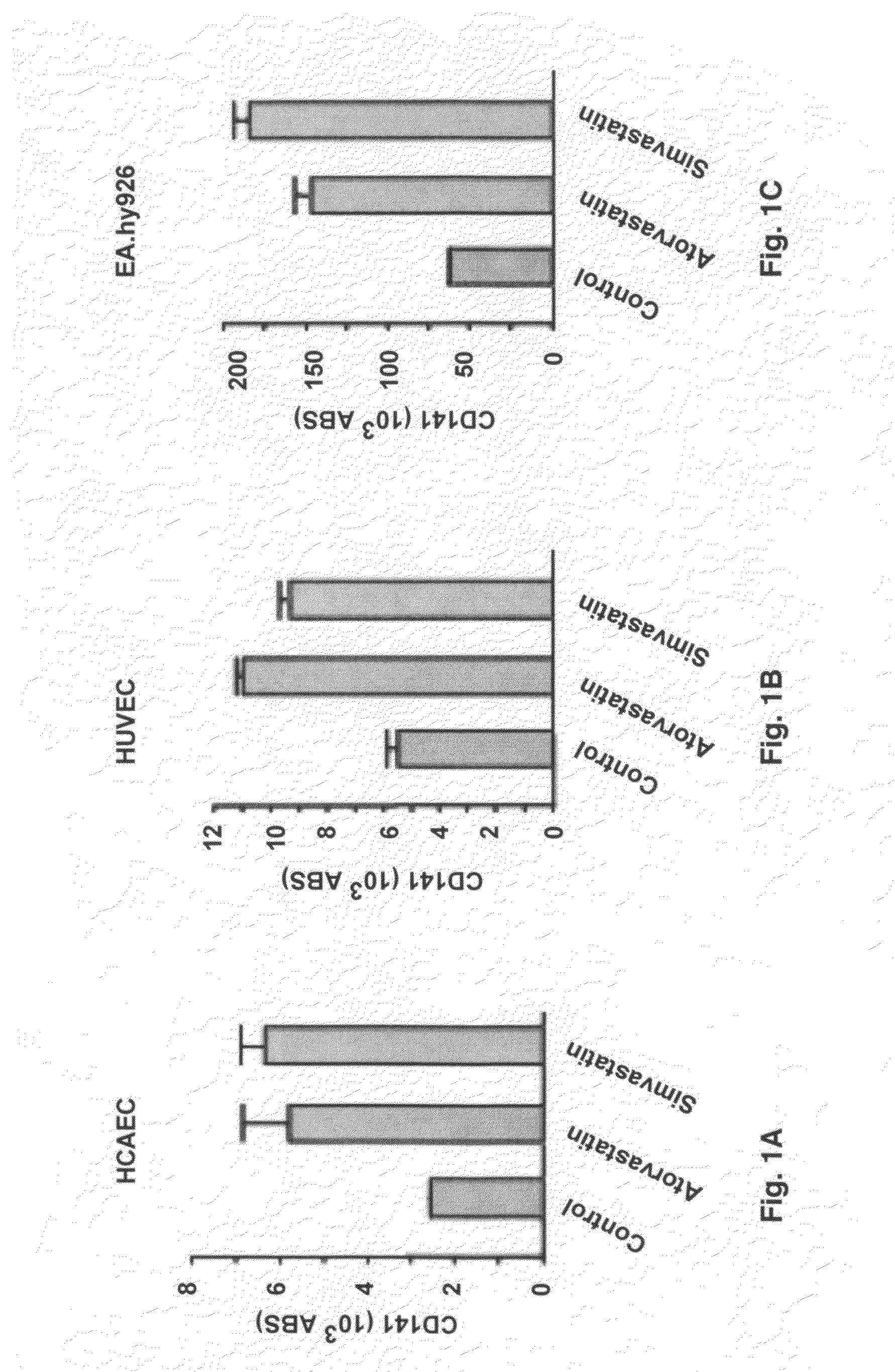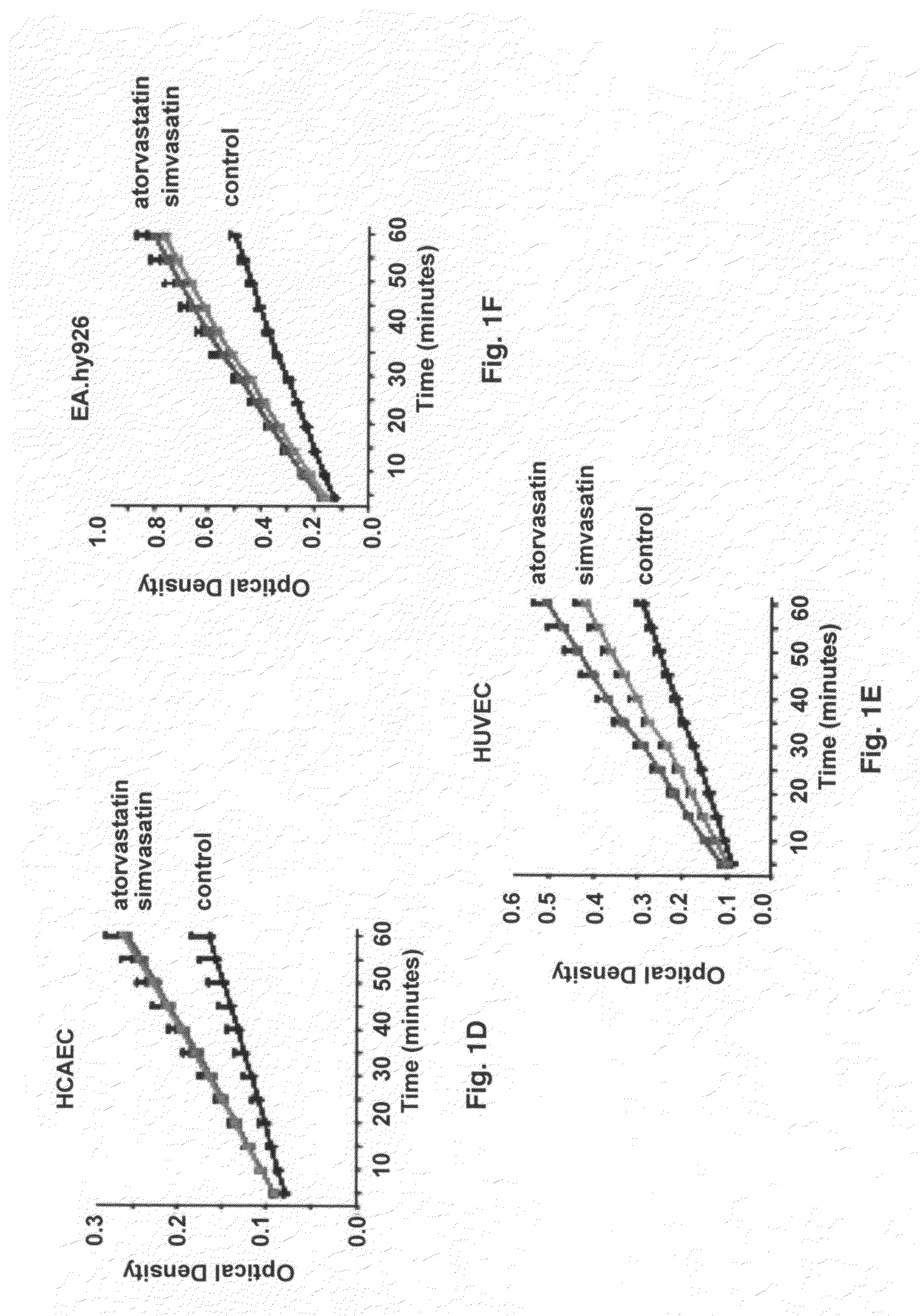Use of statins in the prevention and treatment of radiation injury and other disorders associated with reduced endothelial thrombomodulin
a technology of endothelial thrombomodulin and statin, which is applied in the field of statins, can solve the problems of high cost of recombinant protein administration, significant logistical and pharmacological problems, and strong prothrombotic environment, and achieve the effect of increasing thrombomodulin activity and endothelial cell thrombomodulin
- Summary
- Abstract
- Description
- Claims
- Application Information
AI Technical Summary
Benefits of technology
Problems solved by technology
Method used
Image
Examples
example 1
Reagents
[0047]Atorvastatin and simvastatin were from Pfizer (New York, N.Y.) and Merck Laboratories (Whitehouse Station, N.J.). Mevalonate, farnesyl-pyrophosphate (FPP), geranylgeranyl-pyrophosphate (GGPP), squalene, zaragozic acid A (ZGA), 3-(2-Hydroxy-2-nitroso-1-propylhydrazino)-1-propanamine (PAPA-NONOate), 3-Morpholinosydnonimine hydrochloride (SIN-1), and 2-Phenyl-4,4,5,5-tetramethylimidazoline-1-oxyl 3-oxide (PTIO) were from Sigma Chemical Co. (St. Louis, Mo.); geranylgeranyl transferase I inhibitor (GGTI-298) and farnesyl protein transferase inhibitors I and II (FPTI-I and FPTI-II) were from Calbiochem (San Diego, Calif.). Recombinant hirudin and human protein C were from American Diagnostica (Greenwich, Conn.); chromogenic substrate for activated protein C was from Chromogenix (Milano, Italy); and human recombinant tumor necrosis factor-E\ (TNF-£\) from R&D Systems (Minneapolis, Minn.).
example 2
Endothelial Cells
[0048]In vitro studies were performed using human endothelial cell lines. Human umbilical vein endothelial cells (HUVECs) and human coronary artery endothelial cells (HCAECs) were from Clonetics (San Diego, Calif.). EA.hy926 endothelial cells are an immortalized cell line that is a hybrid between human umbilical vein endothelial cells (HUVECs) and a lung (type II pneumocyte) adenocarcinoma cell line. This cell line, originally obtained from Dr. Cora-Jean S. Edgell in the Department of Pathology at the University of North Carolina, is widely used for endothelial cell studies.
[0049]Human umbilical vein endothelial cells were cultured in EGM-2 Bulletkit medium containing endothelial cell basal medium-2 (EBM-2) and EGM-2 SingleQuots (hEGF, hydrocortisone, hFGF-B, VEGF, R3-IGF-1, ascorbic acid, Gentamicin, Amphotericin-B, fetal bovine serum, and heparin). Human coronary artery endothelial cells were cultured in EGM-2 MV BulletKit medium containing EBM-2 with hEGF, hydroc...
example 3
Fluorogenic Probe RT-PCR
[0050]Steady-state TM mRNA levels were measured using quantitative real-time RT-PCR (Dr. G. Shipley, Quantitative Genomics Core Laboratory, University of Texas Health Science Center, Houston, Tex.). Human thrombomodulin and b-actin fluorogenic oligonucleotide probes and primers were designed from Genbank sequences, using Primer Express software (Applied Biosystems, Foster City, Calif.) and synthesized by Biosource International (Camarillo, Calif.). Total RNA was extracted using TRIZOL Reagent (Invitrogen, Carlsbad, Calif.) and the RNA samples were treated with RNAse-free DNAse I (Promega, Madison, Wis.). cDNA was synthesized from total RNA in 10 μl total volume, consisting of 6 μl RT master mix (Invitrogen, Carlsbad, Calif.) and a 4-μl RNA sample (30 ng / μl), using a thermocycler (MJR, Waltham, Mass.) for 30 minutes at 50° C. followed by 72° C. for 10 min. Samples were measured in triplicate. An assay-specific sDNA standard spanning a 5-log range and appropria...
PUM
| Property | Measurement | Unit |
|---|---|---|
| Fraction | aaaaa | aaaaa |
| Fraction | aaaaa | aaaaa |
| Fraction | aaaaa | aaaaa |
Abstract
Description
Claims
Application Information
 Login to View More
Login to View More - R&D
- Intellectual Property
- Life Sciences
- Materials
- Tech Scout
- Unparalleled Data Quality
- Higher Quality Content
- 60% Fewer Hallucinations
Browse by: Latest US Patents, China's latest patents, Technical Efficacy Thesaurus, Application Domain, Technology Topic, Popular Technical Reports.
© 2025 PatSnap. All rights reserved.Legal|Privacy policy|Modern Slavery Act Transparency Statement|Sitemap|About US| Contact US: help@patsnap.com



